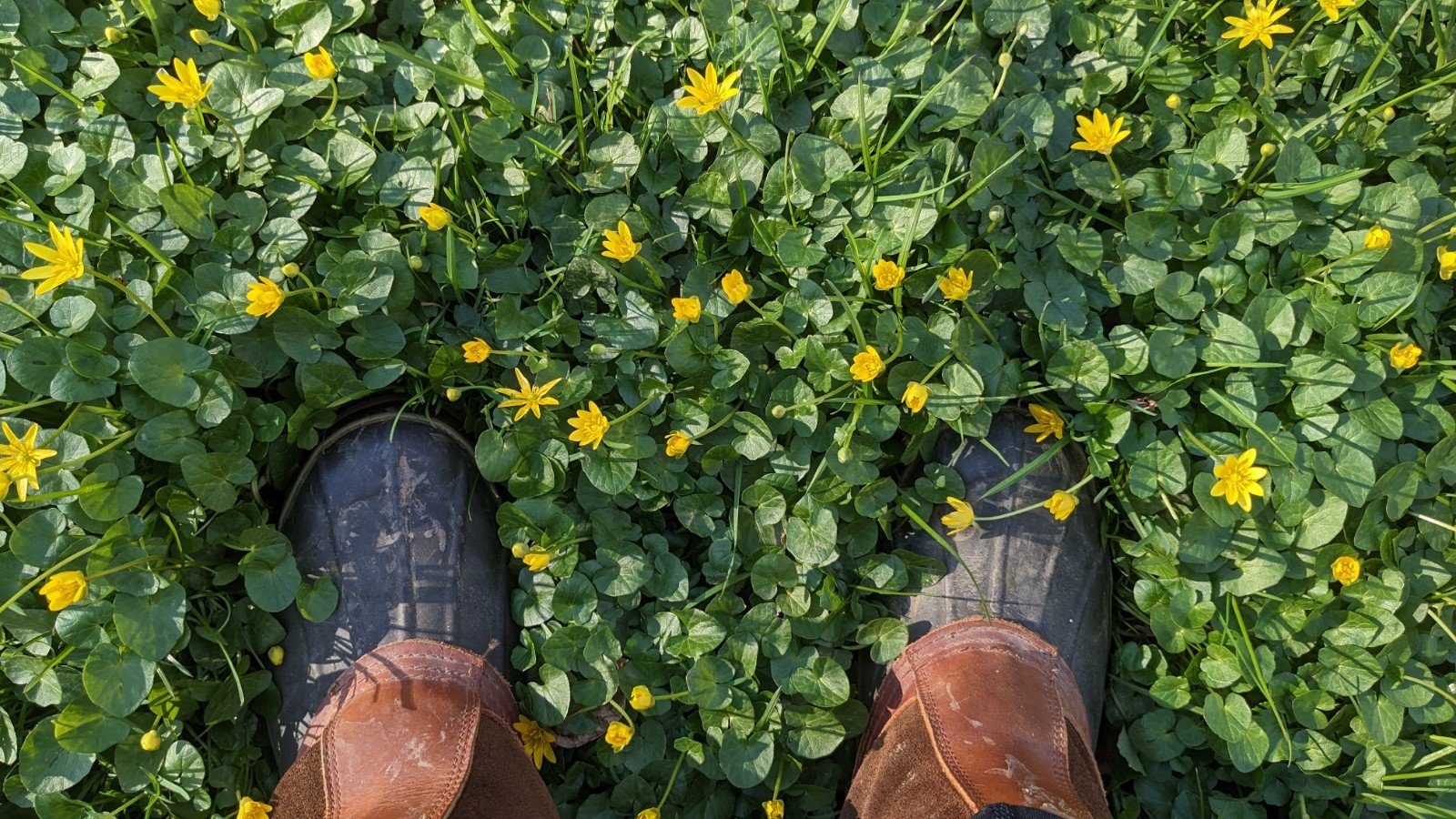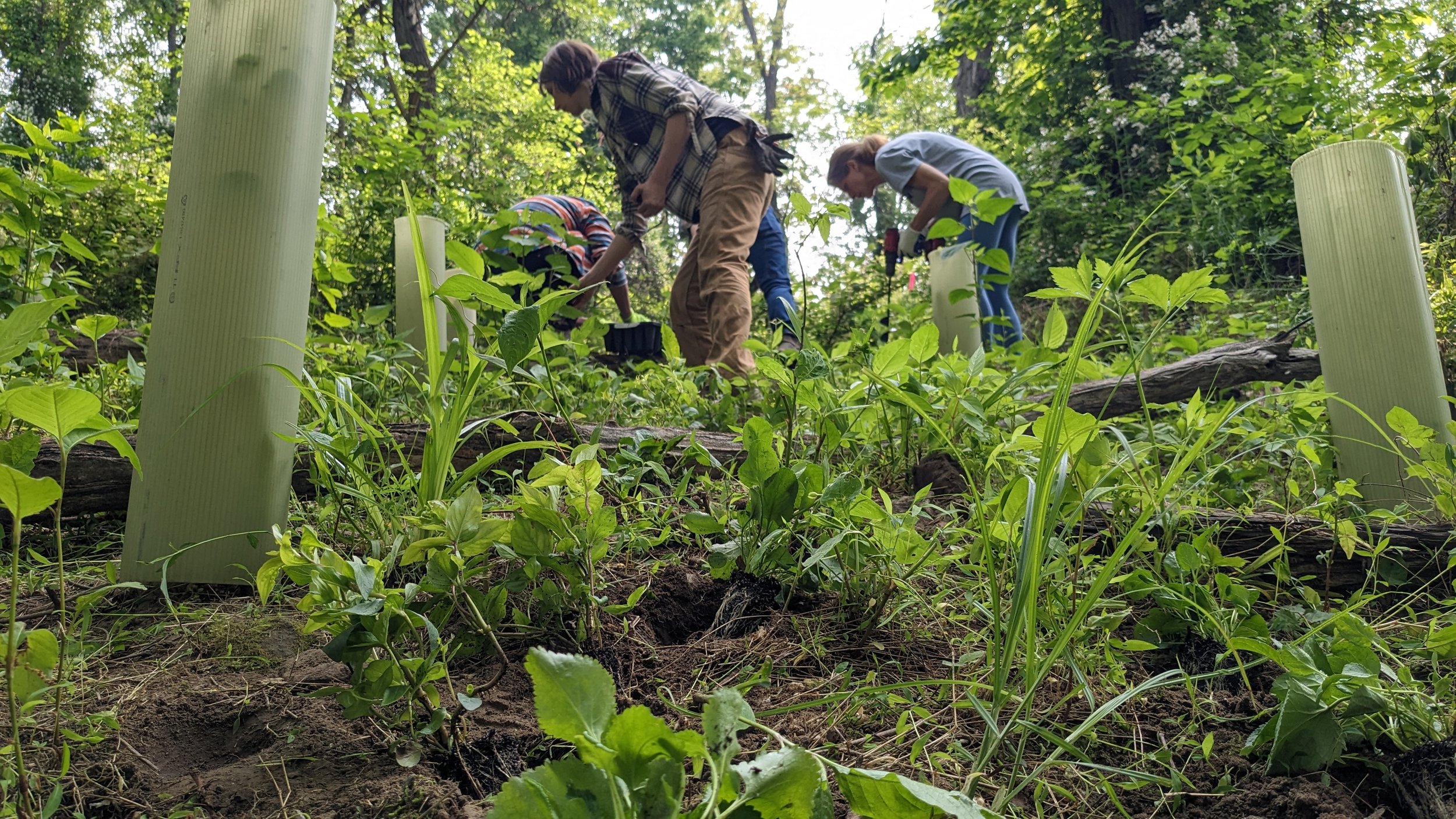When facilitating the Habitat Advocates and Ecological Gardener Training programs, I am often questioned about the quandaries of how to ecologically approach land that is inundated with assertive introduced species, like; bush honeysuckle, lesser celandine, and stilt grass.
Emotions and energy are often peaked, accompanied with well intentioned focus to immediately eradicate these increasingly common areas where we live, work, learn, play, and worship. My response to this inquiry is one that is not often desired.
First, we must take a deep breathe and then, OBSERVE.
Lesser celandine (Ficaria verna) along the Little Conestoga River @Waxwing HQ, Lancaster PA.
“Gahhh!” I can hear you gasp, as you see this unwelcomed sea of yellow. Why not immediately react?
At the new Waxwing HQ, observation has been crucial over this first year residing along the Little Conestoga flood banks. An expected flush (approximately 1/4 acre) of lesser celandine (Ficaria verna) occurred throughout the floodplain in Spring 23’. Expected given that the small, dormant bulblets (or bulbils) were observed when walking the site during the house walk-throughs in Fall 22’. Obviously it didn’t disuade me.
A 6-inch spicebush gave me heaps of hope.
I know what you are thinking… spicebush!?!… they are a dime a dozen! But here along the impaired banks of the Little Conestoga, less ecologically interactive species, like bush honeysuckle (Lonicera maackii), dominant the shrub layer, so a little native gem like this is something to celebrate!
This is ecological memory.
Lindera benzoin (spicebush) growing amidst lesser celandine flush.
Due to the inability of lesser celandine to play well with others in this region, with factors out of its control- no natural predators- and some tenacious survivability traits of the species (bulblets and early spring presence), lesser celandine will spread readily, decreasing the biodiversity in its path.
If my response was to react to its uncontrollable nature with glyphosate, a common restoration ecology practice with invasive species, this baby spicebush (and dozens that have been found since), along with other highly beneficial native species would have been lost. It’s like the old medical adage of dosing a wound with rubbing alcohol, now highly discouraged; the repair that you think you are doing to the system may in fact be impairing its ability to heal long-term. Nuking a site isn’t creating a path towards resilience.
In our chosen ecological practice, other than mowing navigation paths throughout the floodplain, all other areas were left unmowed to flush out any intact internal memory (ie; seedbank). By taking the unconventional path of not spraying and leaving ample no-mow areas, in Spring of ‘23, a more desired flush occurred.
What memory was awakened? Spring beauties, Sedges, Fleabanes, Violets, Honewort, and Mayapples! This is why we pause and observe.
Spring beauties and violets in the seedbank @ Waxwing HQ.
Fleabane and violets in the seedbank @ Waxwing HQ.
Mayapples in the seedbank @ Waxwing HQ.
Interestingly the spaces where these botanical lovelies popped up were likely left suppressed for decades. Formerly, this space was routinely mowed. Dozens of native species have since been documented, in just 1 year of “no mow analysis”.
Although in the case of many suburban lawns, exhibited by many of Waxwing’s customers, the ecological memory has been almost entirely lost (aka: ecological amnesia). Lawn sprays, soil compacting mowers, or simply the initial developers removing the intact topsoil of the neighborhood contributes to this loss. A year of no mow analysis is unnecessary and may in fact be harmful to the intended ecological pursuits in these human dominated spaces. A full habitat revamp (minus the few hearty violets and sedges found) is often needed by smothering the lawn and designing a native plant palette, inspired by naturally occurring native plant communities.
No mow floodplain areas along the Little Conestoga @ Waxwing HQ.
As exhibited, within spaces like this floodplain at Waxwing HQ, there could be treasure troves of hidden natives that may simply need a little (or a lot) of non-chemical TLC. What these types of spaces don’t need is reactionary spraying that will only create additional quandaries of erosion and loss of cover for wildlife. After observation, it becomes apparent that a phased plan is needed, combining conscious removal, outcompeting in patches with select native species, and bolstering with larger sweeps of a designed site-specific native plant community. A simple dichotomous key decision tree for taking action in these increasingly common spaces can be found below;
In my training courses, we simply use a Venn Diagram to determine the characteristics that capitalizes on the difference of the undesired competing species, leading to a list of high functioning native plant species that can hold a candle, or better yet, fully outcompete the less desired, poor ecologically performing species. Again, without needing to use chemicals, like glyphosate, that the EPA has reported harms 93% of endangered species (and you).
The “bolster the banks” of the Little Conestoga experimental project began in Fall 22’ (with phased extension plantings since), a spot predominated by lesser celandine and another uninvited guest, goutweed. The ecologically underperforming introduced species were manually removed via a broadfork (bulbets of celandine still present). This was conducted after initial observation of existing populations of wood nettle (Laportea canadensis), common milkweed (Asclepias syriaca), and wingstem (Verbesenia alternatifoia) that seemingly were not outcompeting the goutweed, though each holding a vibrant candle. A small test patch was planted by immediately chasing with semi-evergreen and other hardy native plants like tufted hairgrass (Deschampsia cespitosa), cutleaf coneflower (Rudbeckia laciniata), Germander (Teucrium canadense), a variety of semi-evergreen sedges (Carex spp.)., and Packera aurea (golden groundsel)- a species in the wholesale trade whose genetics exhibit a more rhizomatic tendency than its more timid local ecotype cousin in the piedmont of PA. A favorable genetic attribute for ecological restoration folk? Perhaps a question for a separate blog post. Several of these species hold a characteristic- being evergreen- a trait not exhibited in lesser celandine.
The idea being that instead of haphazardly nuking our poor ecologically performing sites, a small and slow (my fav Permaculture principle) solution is trialed, ensuring long-term manageability of site and respect to the nursery people, plants, and your pocket!
Best practice is to first small patch test, then scale up if resources allow.
Deschampsia cespitosa and a variety of semi-evergreen Carex species (a little Lobelia cardinalis peppered throughout) planted as a test restoration plot along the Little Conestoga.
More insight over the last 4 years has been gleaned on a larger site along the Lititz Springs with Packera experimentation (and other native ally species), with a Waxwing co-stewarding customer (a monthly service offered for inquiring customers that seek to steward their properties alongside a trusted professional). Where once lesser celandine flushed out in full glory, Packera and other allies now reside. Those that know my favorite native plant allies, won’t be surprised that sedges (I can hear the latest Habitat Advocate graduates chuckling ;)) take precedence as well. Wild oats (Chasmanthium latifolium), hoary mountain mint (Pycnanthemum muticum), wild ryes (Elymus spp.), and several of the other trialed species were then later discovered on Nancy Lawson’s helpful guide of “How to Gently Fight Plants with Plants”.
Waxwing planting of Packera aurea, along the banks of Littiz Springs. Lititz, PA.
Waxwing planting of a diversity of Native Plant Allies, along the banks of Littiz Springs. Lititz, PA.
As part of the Ecological Gardener Training program, in collaboration with the Horn Farm Center, we study these stewarding techniques of mindful removal of invasives and competitive exclusion to encourage the ecological memory residing within the novel ecosystems growing at the Horn Farm.
Throughout the 16-week hands-on training, our learning adventures begins with observation of intact thriving ecosystems, to site analysis, to research and design, then ultimately to bolstering a site. The site cases for the 2023 cohort exhibited many bare soil gaps after selective hand pulling of invasives. Trainees enhanced the tapestry of interactions by selecting species that mingled well with those unveiled and also exhibited characteristics that would give them a leg up in considering the competitive exclusion principle (yes, my favorite, sedges, were on the list!). Trainees use resources like the Terrestrial and Palustrine Plant Communities of Pennsylvania, which help inspire the handy Hungry Hook’s Plant Community’s Key, to discern which species can bolster a site that was formerly site prepped via hand removal of invasives species.
Highly disturbed spaces may appear at quick glance that they lack the ability to rebuild complex ecological interactions, however with a calm and compassionate human hand, robust levels of resilient native species, whether internally or encouraged from adjacent ecosystems, can awaken the ecology that once was vibrant and thriving. Let’s be agents of unearthing ecological memory, ecological gardeners!
Ecological Gardener Training Program at the Horn Farm, 2023 cohort. Assessing ecological memory and bolstering the habitat with site-specific native plugs. York, PA
Have you engaged in non-chemical ecological stewarding? Do you love experimenting with outcompeting undesired invasive plants with ecological robust native plants? Give the post some “Love”, “Share” with a friend, and/or comment below! Thank you :).











